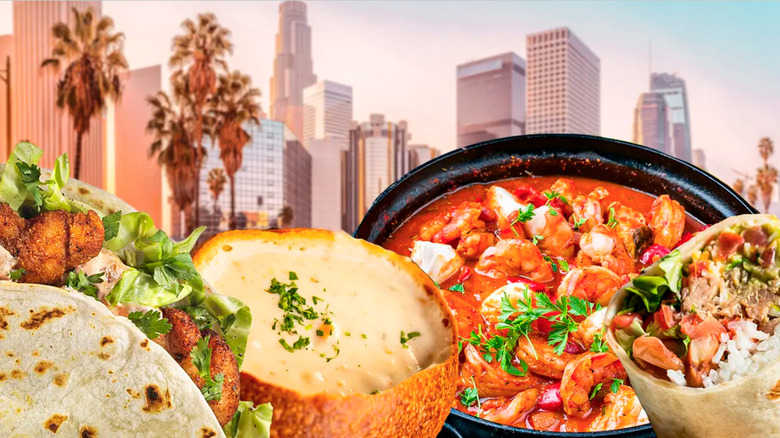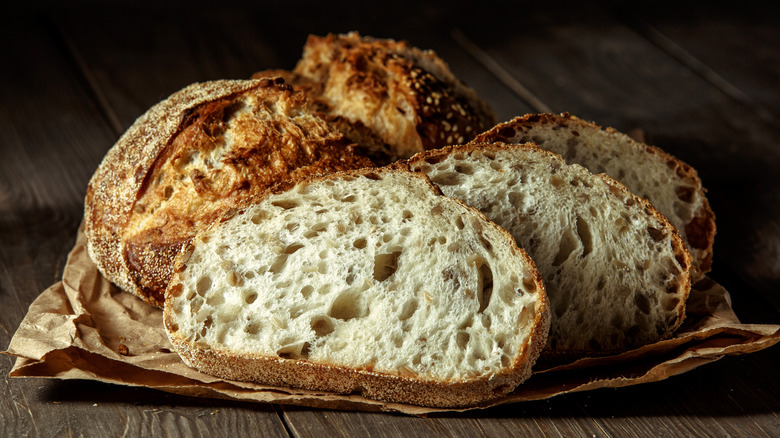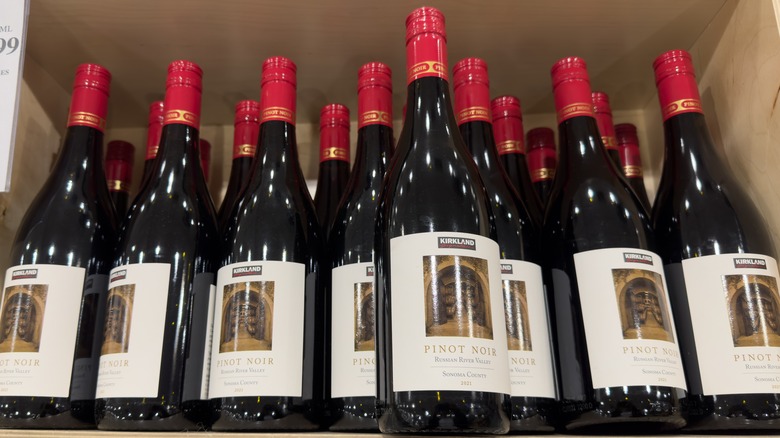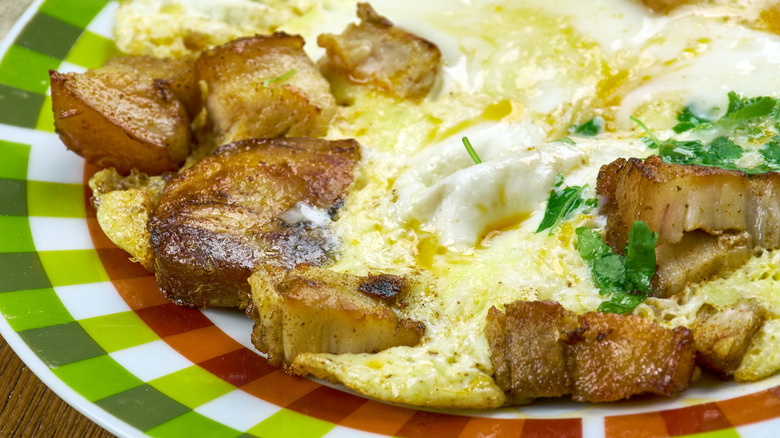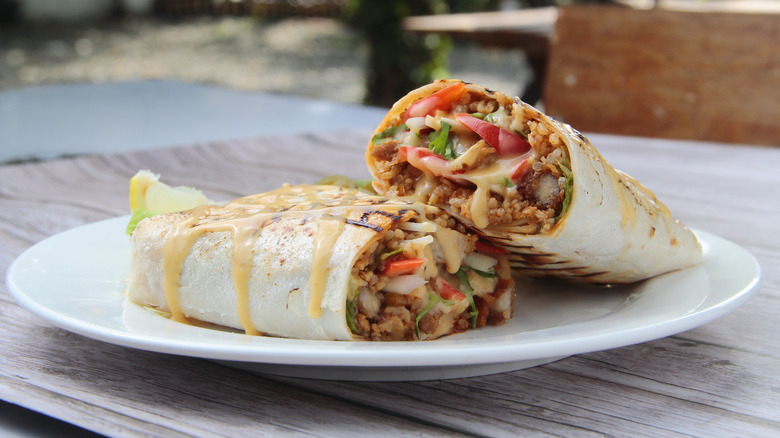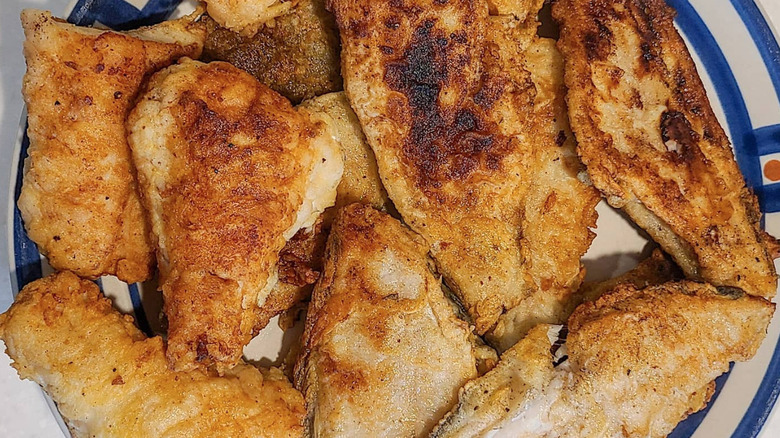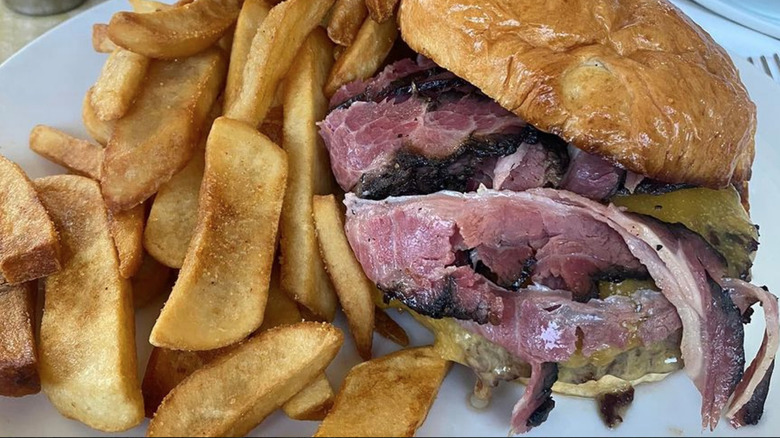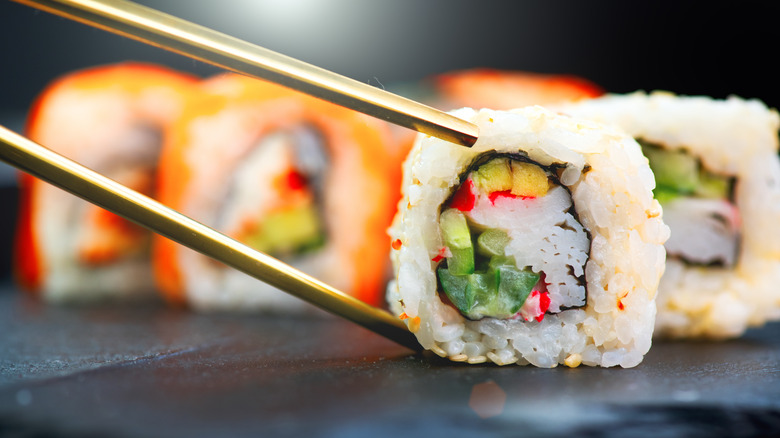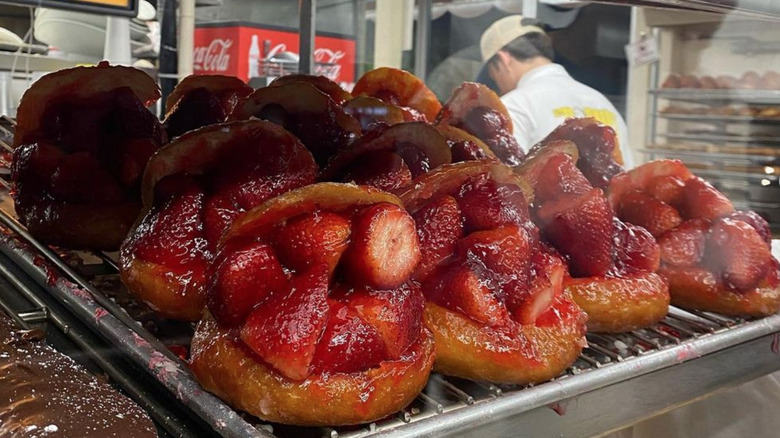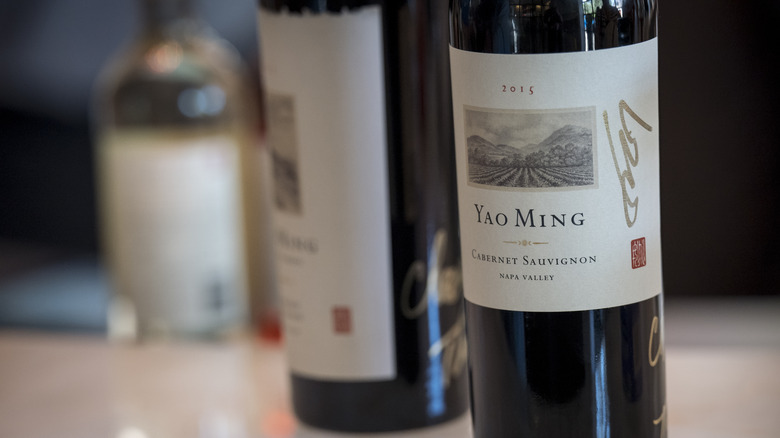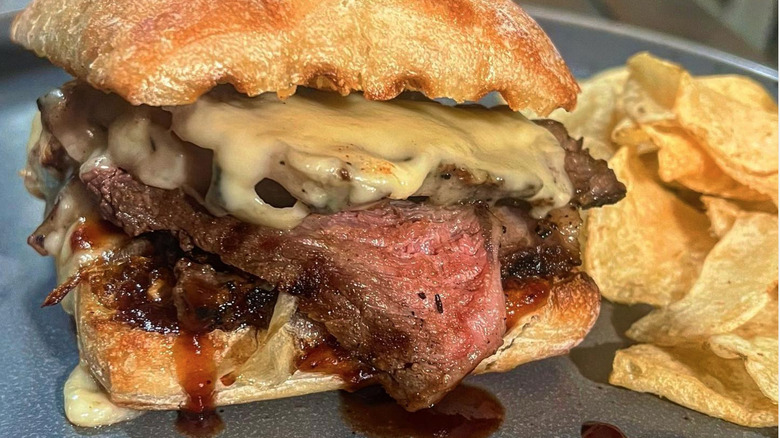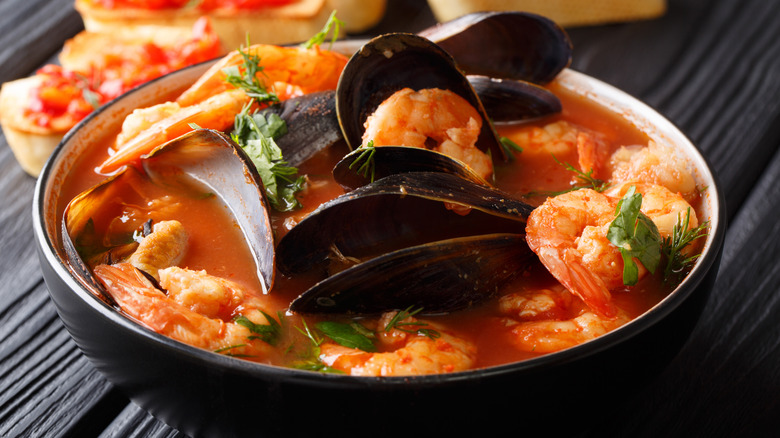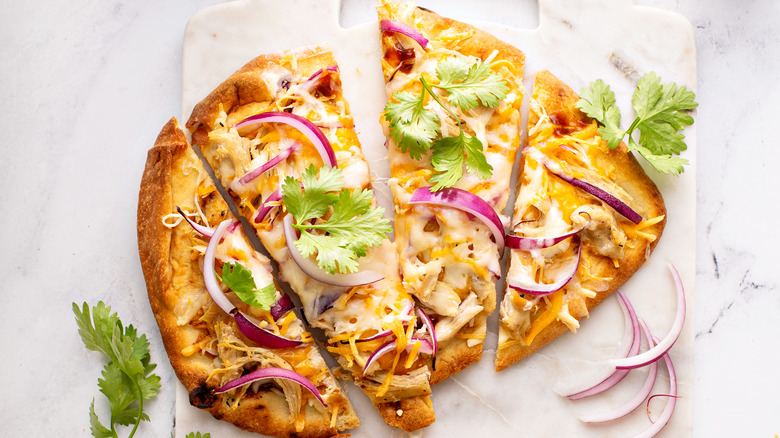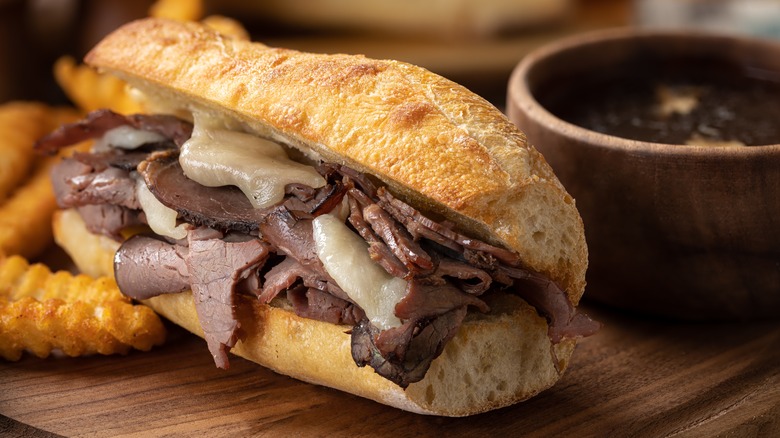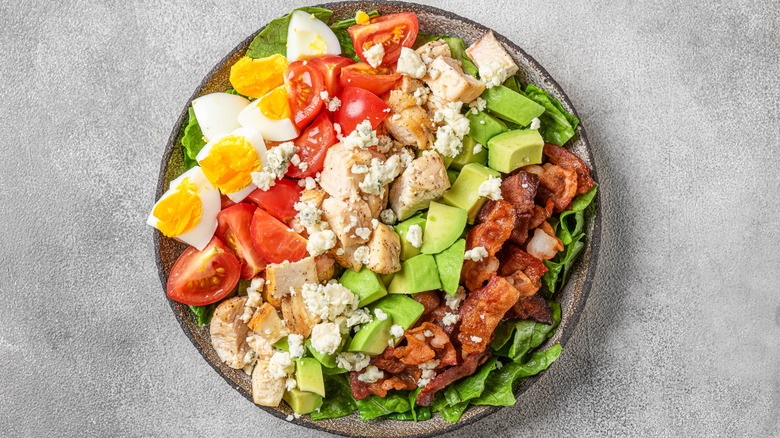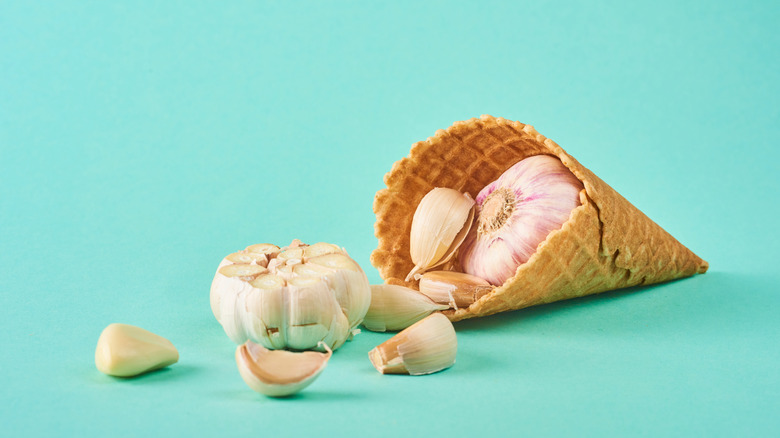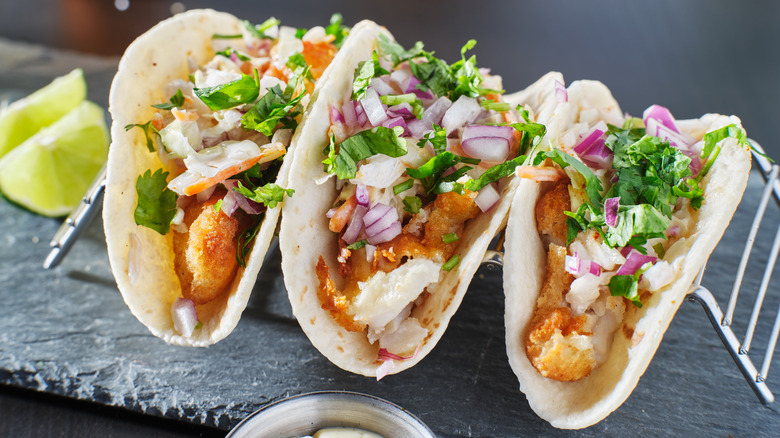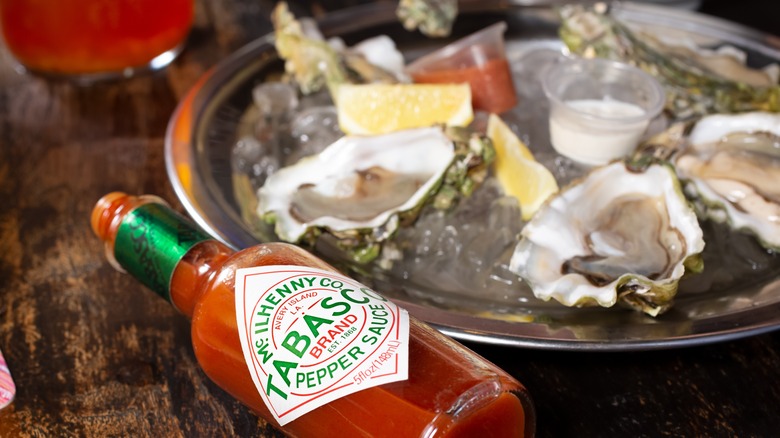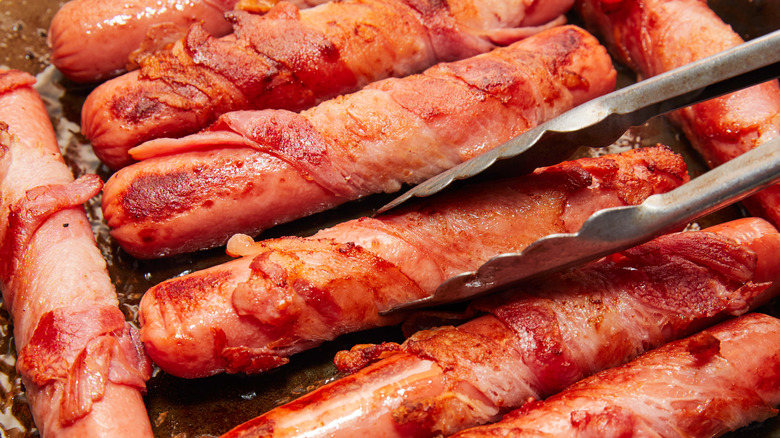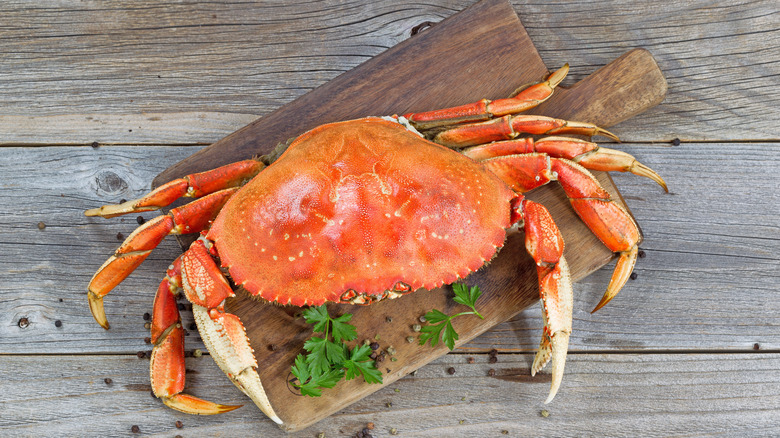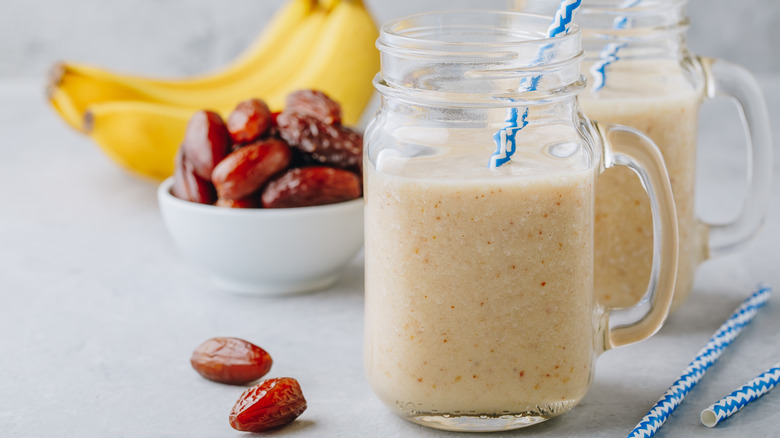20 Unique California Foods You Need To Try
Californian cuisine — what exactly does that mean? To some, perhaps all that comes to mind for gastronomic experiences along the golden coast are cold-pressed juices, salads galore, and avocados on essentially everything ... especially toast. And, while all of these are indeed food items that can be found in plenty of supply anywhere along the California culinary corridor, they by no means encapsulate even the beginning of a comprehensive rundown of uniquely Californian foods. In fact, this western state has contributed some downright delicious delicacies in the realm of dishes and has served them up to locals and visitors alike.
Some Californian foods are well-known, and some may surprise even the most food-loving locals. But whether you're a local Californian, a curious out-of-state foodie, or an inquiring mind from far-off lands, it's time to delve in and learn all about foods with roots deeply engrained in the Golden State.
San Francisco sourdough
San Francisco sourdough lays claim to some of the most downright delicious sourdough starters on the planet. Something about that humidity, that sea air, that West Coast vibe ... it makes the best bread out there. But how does San Francisco sourdough differentiate itself from the rest of the world? Well, it's literally in the air. For those not in the know, sourdough is unique among bread and bread products as the dough has actually undergone a fermentation process, which is what gives the resulting loaf its recognizable and relished tangy flavor. There's a quality to the bacteria in San Francisco that gives the sourdough a singular flavor that cannot be replicated outside of the city.
Historically speaking, San Francisco sourdough was developed during the gold rush using wild yeasts caught from the air to flavor bread dough starters. Boudin Bakery in San Francisco claims that they still use the same starter for their sourdough that was used in the mid-1800s to feed hungry miner 49ers. How's 200-plus-year-old bread that can only be made in the great Bay Area for uniquely Californian food?
Central Coast pinot noir
It's impossible to discuss Californian cuisine without at least acknowledging the prowess of a Central Coast pinot noir. Californian wine is, in general, revered for its quality that is said to rival even the world-famous ferments of Europe in countries such as Italy and (perhaps more impressively) France. Pinot noirs are a delicious type of wine and they boast noticeably sweet and fruity notes — many a wine lover will swear by the distinctively bing-cherry-like notes that differentiate a pinot noir from other reds and red blends.
While the central coast of California spans a long expanse of the state's western border, the wine from Paso Robles is especially revered. This is in part due to the ideal weather, terrain, and the freedom to ferment that the winemakers of Paso Robles enjoy. Whatever the reason, it's hard to pass up the quintessentially Californian experience of sipping a Central Coast pinot.
Hangtown fry
The moniker "Hangtown Fry" may lead the uninitiated to presume that this dish rests comfortably in the realm of simple and delicious breakfast omelets. Fortunately, this is an incorrect assumption, as the Hangtown Fry is actually a historically significant breakfast food hailing again from California's gold rush era. Though the origins of this oyster-filled omelet are a point of contention, the recipe and its deliciousness are both beyond dispute.
Despite most rumors placing the creation of the Hangtown Fry farther inland in Placerville (once called Hangtown) where the oysters had to be transported on ice, the restaurant with perhaps the most claim to fame when it comes to its Hangtown Fry is San Francisco's Tadachi Grill, where the omelet has been served for over a century and where Anthony Bourdain stopped for an interview in his heyday. Given the plentiful nature of oysters in California's Pacific Ocean, alongside their energizing, delicious, and healthy attributes, this may be the best and most underrated contribution California has made to the culinary canon.
Mission-style burrito
The Mission-style burrito is easily identified as a standout, even among all of California's other contributions to the world of exceptional eats. This particular burrito was invented in the Mission District of San Francisco during the 1960s. Believe it or not, the mid-1900s was a time period where Mexican food was nowhere near as popular or accessible, even though it has now surpassed Italian food in popularity and has become an undeniable state staple.
The Mission-style burrito is unique from other burritos for a number of reasons. Primarily, the large size, the inclusion of rice, and the finishing touches of grilling the wrap and wrapping it in foil are what set the Mission-style burrito apart from others of its kind. Though it may be difficult to conceptualize a burrito that isn't packed to the brim with all the current standard and accepted accouterments, the Mission-style burrito was a revolutionary recreation that preceded the much-beloved California burrito (fries, carne asada, guacamole, and all) as well as the Chipotle craze.
Sanddab
The Pacific Sanddab is a fish — a small, delicious, and completely native to the West Coast of America's flounder kind of fish that may be baked, battered, fried, filleted, or otherwise served fresh. From California's northernmost coast and all the way down to San Diego's beach-side restaurants, the Pacific Sanddab is a quintessentially Californian fish dish.
The University of California, San Diego, studied the sanddab and noted some highlights, including that the Pacific Sanddab has both of its eyes on the left side of its face, can live for close to a decade, typically reaches around 5 inches in length, and is not a fish considered at-risk for overfishing and population reduction (at least at the present moment). This means that fish-loving foodies can feel good eating and enjoying a plate of Pacific Sanddab since it is most certainly a more sustainable selection of seafood than abalone, salmon, or the various types of tuna.
Pastrami burger
There's no way to go wrong with a good ol' fashioned Californian take on the classic hamburger, piled-high with pastrami and served with a side of thick, crispy french fries. Though the addition of pastrami to an already beef-centric dish may seem like overkill, the reality is anything but. Suptous bites of bun and burger meld in your mouth alongside the unmistakable umami zing of pastrami. The result? A taste so complex, so flavorful, so meaty (but not too much) that you may not be able to go back to regular burgers ... after all, once you've tasted perfection, there's no way to go back to banality.
The pastrami burger definitely ranks among the best burgers in the United States and is best served with melty cheese and pickles nestled in among all the pastrami. For a truly Californian twist, add a thousand island dressing and shredded lettuce to marry the quintessential In-n-Out experience with the pastrami and beef patty party.
California roll
In California, these specific sushi rolls are king among on-the-go snacks and sit-down dinners alike. The classic California roll is a favorite for both sushi snobs and those revolted by even the thought of eating raw fish — this is because the cooked crab filling that comprises most of the California roll's ingredients offers both high-quality seafood (to please the snobs) and delicious, decidedly cooked flavors and textures to appeal to the less adventurous sushi savants.
California rolls contain, on the most basic level, crab, cucumber, and avocado wrapped in seaweed and rice. From there, the options for personalization and pizazz are only as limited as the imagination of the sushi chef. Common add-ons to amp up the basic California roll flavors include a toasted sesame seed or fish egg (or roe) garnish on the outside. Imitation crab is frequently used in the making of California rolls, making the dish accessible to lower income brackets and those with shellfish allergies.
Strawberry donut (Donut Man)
Some things seem so simple, they should be popular everywhere — such is the story with the strawberry donut at Donut Man in Los Angeles. While there are most likely many donut hole-in-the-wall establishments selling strawberries on donuts, few (if any) do it better than Donut Man. Considering the sheer number of delicious donut dining options in LA, it truly is an impressive feat to be recognized as the irrefutable best of the best. Just imagine — succulent, juicy, sweet strawberries, glazed red and piled high on top of fluffy fried vessels (aka donuts). One bite will flip your world on its axis and make donut cravings take on a whole new meaning.
The Californian aspect of this is in the quality and size of the strawberries, as Californian strawberries are notable both for sublime sweetness and substantial size, making them the perfect addition for a West Coast donut: half fruit, half fry, all tasting absolutely divine.
Napa cabernet sauvignon
The Napa Valley region of California's greater northern Bay Area is host to some of the world's finest wines, chief among them being the nationally-renowned Napa cabernet sauvignon. Napa cab, as the wine is more colloquially called, is well known in and outside of the West Coast for its high quality as well as its deep and notable flavors of plum, molasses, and black berries such as black currant and boysenberry.
Among all of the wineries in the area, nailing down the very best Napa Valley winery is nearly (if not entirely) impossible. After all, the Napa Valley region is a famous wine destination, one which attracts people to travel from far and wide to experience. Many proposals, bachelorette parties, weddings, birthdays, and other celebratory events have taken place nestled deep in the heart of this wine county and with the unmistakable taste of Napa cab on the tongue.
Tri-tip sandwich
If you've never heard of or tasted the unmistakable flavor of tri-tip fresh off the grill and sliced right, then it may be time to book a flight to California for a bite. After all, this is one of the most flavorful, tender, and desirable cuts of beef known to man. Simply slap some seasoning on this cut of meat, stick it on the grill, take it off, let it rest, slice against the grain, and serve — preferably on a sandwich, smothered in cheese and nestled safely between two slices of crunchy bread.
This underrated cut of beef is delicious when served in many forms: as tri-tip tacos or as a steak or a garnish on salads or as one of many meats in a smorgasbord of Californian BBQ. In fact, tri-tip is an incredibly diverse cut that can be sliced paper thin, steak-sized thick, or diced large and small. But, in California, the best and most popular mode of tri-tip consumption is sandwich style.
Cioppino
Cioppino, or catch of the day seafood soup, is a simple recipe that hails from the hallowed halls of the San Francisco fishing industry (and with the help of Italian-American immigrants). The concept behind cioppino is simple: just combine a fish broth, akin to that used as the base of a traditional French bouillabaisse, with tomato, white wine, and various herbs and spices. Some recipes call for chili flakes, some bay leaves, parsley, and thyme, others saffron, and some mix and match.
Once all desired cioppino ingredients are combined, simply simmer the soup base with the seafood available that day. In order to properly layer the soup, different fish types must be staggered and added in order of longest to shortest cook time. In other words, quick-to-cook fish, such as shrimps and scallops, would be added to a cioppino at the very end of cooking, while mussels, crabs, or clams are best added 10 to 20 minutes earlier.
The kind of fish used matters very little when it comes to a cioppino, and the only requirement is that one uses the freshest fish on-hand to make the simple soup shine. One bite, just a small spoonful, of correctly-cooked cioppino will have your tastebuds exploding with delight.
Artisanal flatbreads
In California, nothing hits home after a long day (or a short bite with a beer) quite like an artisanal flatbread. Yes, artisanal flatbread may sound like two made-up buzzwords smashed together to create a pretentious-sounding meal without substance, but the reality is staggeringly delicious. The principle behind this California-style pizza isn't so much in the size or shape — rather, what sets Californian flatbread apart from the rest of the United States is its reliance on fresh and local ingredients.
Many a Californian has been teased for the appearance of the local pizza, in part due to the fact that they often look like a flatbread with a salad piled on top. But this fresh, vibrant, daresay healthy touch is exactly what makes Californian-style artisanal flatbreads so flat-out delicious. There is no limit to what can be put on a pizza, and that extends to farm-to-table fresh fruits, veggies, cheeses, and more.
French dip sandwich
This dip may be named "French," but the taste of this sumptuously juicy marriage of meat on bread is all west coast. History places the invention of this succulent sandwich in the early 1900s-LA, specifically at a restaurant called Cole's. Rumor has it that a sympathetic and overall indulgent chef dipped a customer's sandwich in some leftover au jus to make it easier to eat (due to alleged tooth problems on the consumer's behalf). The result? A Californian culinary creation that is half sandwich, half soup, and all so darned good it's almost hard to conceptualize.
The recipe for a French dip sandwich is simple: just pile your halved baguette loaf high with your favorite cut of beef, top it off with some Swiss cheese, toast and melt everything together, and serve alongside a concentrated beef consomme (for dipping purposes). The end result will leave you wondering why all sandwiches aren't served with a dipping soup side.
More hardcore French dippers include horseradish spreads to add a bite of heat to the sandwich. Additions such as tomato, lettuce, and any kind of veggies, in general, are highly discouraged.
Cobb salad
The Cobb salad is a staple in the lexicon of Californian cuisine and can be ordered in fine dining establishments just as easily as it can be picked up pre-packaged on the go. That is to say, the Cobb Salad is here to stay. Though the original invention of this garden variety salad took place in the golden era of Hollywood — allegedly as a way to combine leftover ingredients for a hungry Southern California restaurant owner — the reach of this meal has, over the past century, extended to every corner of California.
But what's the secret recipe for Cobb salad perfection? Well, just gather a bowl of greens, preferably romaine, iceberg, butter lettuce, or a more neutral tasting green, chop it up, and top with neat rows of tomato, boiled egg, chicken, chives, avocado, bleu cheese, and bacon, then dress with a red wine vinaigrette. And presto — the Californian Cobb salad.
Garlic ice cream
Welcome to Gilroy, California — located just a little bit east of the fan-favorite tourist/university/beach town of Santa Cruz and home of the famous Gilroy Garlic Festival. And, more importantly, the origin of the uniquely Californian food: garlic ice cream, which tastes like a surprisingly pleasant rendition of a cold, creamy, and decidedly fresh head of garlic. This combination may sound like exactly the weird Californian culinary catastrophe you may want to avoid but, like many things in life, you'll never know unless you try it!
There's no better place to try garlic ice cream than Gilroy, where (alongside questionably savory garlic ice cream) garlic is and has been celebrated in all of its edible forms for almost 50 years. Unfortunately, the festival itself has been canceled due to the COVID-19 pandemic and a shooting incident in 2019, and the city's financial troubles. Regardless, Gilroy, California is still the epicenter of all things garlic.
Fish tacos
Mexican food and Californian cuisine go hand-in-hand — this is an undeniable fact. After all, California once belonged to Mexico and the state boasts a high population percentage of Mexican inhabitants. This good fortune explains famous food contributions, such as the fish taco, which has become incredibly popular in the day-to-day Californian diet. In fact, fish tacos are just as popular as counterparts such as carne asada, birria, and al pastor.
The fish in a fish taco should be battered and fried, leaving a crispy exterior and a moist, flaky fish interior. After that, the interpretation of the fish taco is entirely up to the fish-taco aficionado. Some chefs may whip up a creamy coleslaw to top the taco, while others prefer the simplicity of a sprinkle of onion, cilantro, and lime. Other optional toppings include radish, pico-de-gallo salsa, and (of course) hot sauce. Just for the halibut, consider a trip to southern California's best taco spots and treat yourself to an indulgent tortilla-wrapped treat.
Hot sauce and lime with oysters
Picture this: a table overlooking the grey, expansive waters of the Pacific Ocean, the smell of brine and salt to match the rhythmic sound of waves lapping against the shoreline ... and a silver tray in front of you, piled high with crushed ice, scattered with wedges of lime and lemon, and a dozen raw oysters glistening temptingly on the half shell. Is your mouth watering yet? If not, imagine feeling the feeling of the rough oyster shell against your fingers as you steady it against the incoming wave of citrus, freshly squeezed, and the classic Californian twist: hot sauce.
There are so many ways to enjoy an oyster; with the traditional sherry and shallot vinaigrette, with horseradish, or grilled with garlic and parsley — but none complement a hot Californian day (or a cold Californian beer) quite like the simplicity of lime juice and a hint of hot sauce. The flavors meld perfectly with the creamy meat and the sea-flavored oyster liquor. And, in many ways, hot sauce and lime-garnished oysters (served alongside a light lager) are the most uniquely Californian food combination.
Mexican street hot dog
At the end of an outdoor event, there is nothing that satisfies better than a Mexican street dog. But what is a Mexican street dog, and how is it different from any old hot dog bought from a street vendor? Well, the answer is so simple you're going to wonder why you didn't think of it ages ago: it's bacon. Mexican street dogs are a classic casual Californian fare and are often found being sold from small carts outside of events such as festivals, conventions, parades, and essentially any event in a large area that promises hungry masses.
The Mexican street dog is reliably always wrapped in a generous helping of bacon, grilled to perfection, and piled high with chilis, grilled onions, and all the appropriate accouterments including optional mayonnaise, mustard, and more. This is not to be confused with the much beloved Sonoran dog, which is traditionally topped off with beans.
Dungeness crab
Nothing says welcome to California quite like the taste of delicious in-season Dungeness crab, preferably one that's been steamed, cracked, soaked in butter, and served on some San Francisco sourdough with a few wedges of lemon. Of course, a few napkins, some specialized culinary implements to crack and pry crab meat from the shell, and a bib are in order to really get the full hands-on stuff-your-face full of crab experience. Between tender bites of buttery shellfish, so soft and succulent they practically melt on your tongue in a wave of sumptuously savory seafood, consider the west coast luxury of fresh and accessible Dungeness crab.
Though there are many kinds of crab on the market, this Californian crustacean stands head and shoulders over its "competitors" — not only is the meat objectively more delicious than other crabs, but it is also the perfect one-per-person sized meal, relatively healthy, and low in calories to boot (if you ignore the butter, of course).
Date shake
From California's most southeastern corners hails a desert dessert so unique, it's worth a whole pilgrimage to Palm Springs just to give it a try. After all, date shakes are a uniquely Californian food that comes from California's naturally arid region where the one and only Coachella Valley plays host to its annual music festival. For locals and transient music lovers alike, it's most certainly worth picking up a world-famous date shake on the way. Nothing beats the heat and treats the tastebuds quite like a cold, rich, sweet smoothie that'll simultaneously cool you down but warm your heart.
The type of dates used in the making of a date shake is incredibly important, and you'll want Medjool above others for its deeply sweet and rich flavor profile. Often, bananas are used to accompany the date shake to augment the natural sweetness as well as contribute texturally to the drink.
